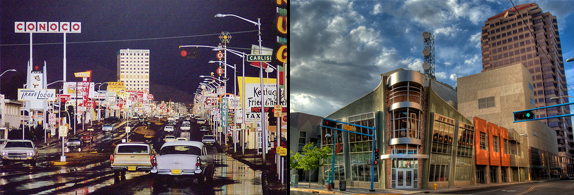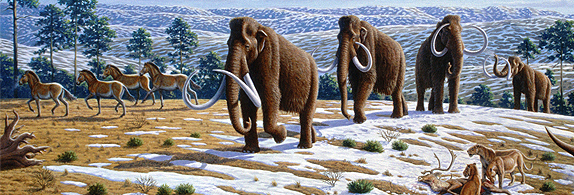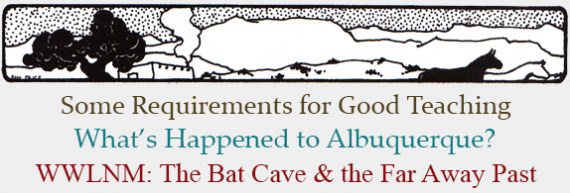Some Requirements for Good Teaching

It never hurts to think about ideal situations. They set the tone for high expectations, especially when it comes to the goals of public education.
I’m about to take a short look at a complicated system from the perspective of someone who has taught high achieving teenagers in the UNM Honors Program and College since l986. My view is idealistic. But it is so, in part, because while criticism of public education in New Mexico is at an all time high, one rarely hears about the alternatives.
First let me ask a question: Which would you consider to be the better educated student: one who, upon graduation from high school, had read and digested in depth 50 to 100 well-chosen books, had acquired proficiency in at least one other language, had a broad experience of the arts and of the history of multiple cultures including their own, had an enlightened citizen’s idea of the scientific method and what it has achieved, had analyzed the U.S. Constitution sufficiently to refer to it while discussing current politics, had good learning relationships with most of her teachers and even considered some of them mentors, and who had written numerous reviews of the books she’d read that were responded to by a teacher she greatly respected, or a student who, upon graduation from high school, had successfully completed numerous tests for which he had been trained by teachers and administrators to take, successfully, with that training amounting to the bulk of his educational experience?
That’s a stark contrast and perhaps an unfair one. But we are in abysmal times where teachers have become victims of politics and corporate profit margins and where students are treated as cyphers to be trained to meet national standards rather than undergoing a purposeful educational experience that leaves them eager and prepared to continue advancing their educations all their lives.
What would an ideal education look like in outline? First, the conditions would have been drastically different than they are today. Teachers would have to be highly respected, well compensated members of the greater community, one which valued education as one of the most important public services government can provide. Schools of education would have to emphasize and reward ongoing research and scholarship by teachers in their academic disciplines. The enormous amount of time prepping for classes, at whatever grade level, and dealing responsibly and maturely with student grading, paper editing, and other out-of-classroom imperatives would have to be socially and professionally acknowledged and recompensed. The political culture of New Mexico would have to change from treating teachers as political footballs and teachers’ unions as subversive enemies of balanced budgets. It would have to recognize teachers “in the trenches” day in and day out for being the public heroes that they are.
As my mentor Katherine Simons, UNM professor of Shakespeare, used to say when someone complimented her on being an inspiring teacher, “good students make good teachers.” Speaking from my temporary perch as an idealist, it must be said that good students are the product of cultures that value learning and see it as the principle activity of the citizen of a democracy and of a person making a living in the world. Good students come from generations of other good students. And good students are almost always the beneficiaries of inspiring teachers building a learning momentum all the way though school from K to 12. Children who are taught by nurturing teachers, who are models of how an educated person pursues their personal, social, intellectual and economic betterment by asking questions and studying with diligence, will grow up with a love of learning.
But teachers must have optimal conditions in which to do their best work. These can be expensive and require a radical change in cultural attitude, but they are critical to inspiring students and keeping the best teachers from burning out.
Those optimal conditions include, above and beyond respectful salaries, relatively small numbers of students in each class. The best results, from my experience, would be no more than 15, with a dozen being the lower end. Anything above 18 and the teacher is already spread too thin. Teachers should not be required to teach any more than three classes a day. They have other out-of-classroom tasks like mentoring speech and debate teams, music and choral teams, as well as doing their daily prep and grading. Five classes of 30 or more students would, and does, break the back of many excellent teachers. Teachers need optimal conditions so they may have more opportunities for one-on-one intellectual exchanges with their students.
Did I get such a public education in Los Angeles in the l940s and l950s? No I did not. Public education has been in crisis for decades. It’s been under funded, under respected, and heavily misunderstood. But there were always great teachers even in the trenches, many of them. They all shared one thing in common. They loved learning and that love of learning overcame all the many slights and injustices they suffered. And because they loved learning they taught us to love it too, to look upon librarians and libraries (and now the Internet) as sources of vast intellectual riches ready and waiting for exploring minds of any age.
I know I’m being idealistic. But I know that people who love learning, who have a passion for it, can become great teachers when given some version of optimal conditions. It’s the way the human species has survived. We are the learning animal. We do it naturally. And for us to not do it well is an anomaly, and the fault, yes the fault, of a system that does not respect education and disrespects educators.
What’s Happened to Albuquerque

In trying to keep track of what’s become of our community and city it’s hard not to see that Albuquerque is in something of daze and a funk. Bad national publicity about police violence has us reeling. Our economy is still in tatters since the great banking roulette disaster when bad home loans exploded the bubble seven years ago. We’re befuddled by the comings and goings of national chain stores and the ominous struggles of, up to now, successful local businesses. Most of us know we’re in the middle of a drought that our elected leaders don’t want to talk about, much less prepare for. We have major water pollution problems that state and federal authorities work to downplay, either out of gross incompetence or official arrogance. I’m not sure which is the more frightening.
We’ve lost political trust particularly in the planning process, with citizen involvement in planning for the Bosque blown off by the mayor’s bulldozers, with huge truck and train facilities going into the Mountain View neighborhood with no consultation with residents, and with an asphalt plant now proposed on South Second almost across the street from the new Valle del Oro Wildlife Refuge, not to mention the initial approval of the ridiculous Santolina Master Plan by the Bernalillo County Planning Commission. It doesn’t matter if it’s in the city or the county, I’d say citizen trust in government is at an all time low. This doesn’t speak well for the prospects of a new Comprehensive Plan and Zoning Code reportedly in the works.
However we also learn, from an insert in the morning paper called Albuquerque Progress Report 2014, that we’re doing pretty darn good too. The report was prepared by a group you’ve probably never heard of, “The Indicators Progress Commission.” The commission evaluates eight community goals and how they support a “vision statement” which reads “Albuquerque is an active, thriving, culturally rich, sustainable, high desert community.”
The report confirms what many of us know intuitively. Here are some highlights: When it comes to “cultural engagement” we’re doing almost the best of any of our immediate competitor cities—Colorado Springs, El Paso, Oklahoma City, Salt Lake City, and Tucson. Comparisons are odious but we’re holding our own. You only have to visit the superb Albuquerque Museum to get a feeling for the vigor and excellence of our cultural life.
When it comes to public safety, however, the results are both paradoxical and very different. In an unspecified survey, 94% of Albuquerque residents “feel safe outside during the day” and 82% of us feel safe outside at night. But only 40% of us “feel APD is respectful to citizens.” And our property crimes and crimes of violence are so high that they leave us in dead last compared to our competitor cities.
As for “public infrastructure,” more of us are using public transit all the time. But we’re dead last in “alternative fuel public stations per 500,000 persons (about 11) and near last in “average internet download speed.” This puts us at a hard to trace, but crippling, competitive disadvantage in the world of electronic business transactions.
Some of the best news is that Albuquerque has by far and away more public open spaces and parks than our competitor cities. The “Environmental Protection” part of the progress report says nothing about ground water pollution, though it does point out that the average person puts 4.8 pounds of trash in the land fill per day while the national average is 2.8 pounds. It also mentions that Albuquerque uses, per capita, 136 gallons of water a day. This is dramatically unsustainable. Even Tucson uses less than we do at130 gallons per capita a day or thereabouts.
And, as many of us know only too keenly, Albuquerque is still mired in a sticky economic slump. We’re in last place with our competitor cities in annual job growth and unemployment rate.
There is a bright note in a category called “governmental excellence and effectiveness.” Our 311 city call center has an average quality rating of 96% and that’s as it should be. The operators on that line are, indeed, the most courteous and helpful civil servants I’ve ever encountered.
Albuquerque is muddling along, doing some things with enormous vitality and success—like the trouble shooting city call center, the city museum, and many governmental or non-profit arts and culture enterprises like the public arts programs and the music and poetry of Sunday Chatter. I won’t reiterate all our woes again. But the core successes and assets of our city still exist waiting to be built upon by a new leadership cadre of vital and forward looking young people who take their city life and health as seriously as they take their own private dealings. These are young people who play politics to win, and who understand that environmental sensitivity and a passion for social and economic justice are good not only for our economy, but for our consciences and realistic hopes as well.
Why We Love New Mexico: The Bat Cave and the Far Away Past Just Around the Corner

Archaeology in the Southwest is among the most fascinating of all scientific enterprises. Not two and a half hours away from Albuquerque a place called Bat Cave, near the plains of San Augustin, contains sediment that reads like an open book about agricultural development in the Southwest. The “cave” is really a number of overhangs that once overlooked a massive lake that used to be 250 feet deep near where the Very Large Array radio telescope complex is today. You can’t go looking for it. It should not be found by tourists. When it was first excavated in the late 1940s, it was thought to contain a 6,000-year-old record of growing corn, beans and squash, the staples of our diet for eons in this region. Later research in the l980s suggested that the corn and squash weren’t as old as first thought, but the bat cave’s stratigraphy still reads like a book of 3,100 years of cultivation .
In a recent issue of Archaeology Southwest, published in Tucson, a fine history of archaeology called “Paleoindians in the American Southwest and Northern Mexico” lays out the fascinating puzzle—dig and spear points and gigantic extinct mammals that roamed our area some 13,000 years ago, including the mammoth, dire wolf, horse, giant ground sloth, tapir, and giant bison.
Of all the fascinations about that period none is more riveting than the speculations of why so many of the “megafauna,” the great animals of era, went extinct somewhere around 13,000 years ago at the end of the Pleistocene Ice Age.
Todd Surovell, an anthropologist from the University of Wyoming, writes that “The end of the last Ice Age in North America was a time of enormous change: mile-thick glaciers were retreating rapidly, the sea level was rising, and large mammals, such as mammoths, ground sloths, camels and dire wolves would soon disappear.” Although a convergence of climate change and Paleo-Indian hunters may be a cause of the great extinction, “researchers still do not know exactly what happened.”
Recently though, Surovell explains that a chemist working at the Lawrence Berkeley National Labs, Richard Firestone, speculated from geologic data he uncovered, that around 12,900 years ago “a comet or asteroid collided or exploded over the earth,” causing a massive glacial melt and horrific shockwaves across North America that “devastated everything in its path,” setting forests ablaze and “drove native large mammals to extinction.” Firestone and his research team found the residue of the impact in sediments deposited around 12,900 years ago. Surovell and others tried to find the same residues and could not corroborate Firestone’s assertions. “However, the debate is far from over,” Surovell concludes, as other researchers are already at work.
In New Mexico and surrounding areas, whatever killed off the megafauna did not kill off the paleohunters that lived with them and preyed upon them, using their beautiful chipped spear tips known as Clovis points. Why were the humans spared? Mysteries abound around New Mexico’s ancient past. And they make the present, with all its troubles and ills, more fascinating than dreadful just by the echo of the imponderable ancient world around us.
(Photos: Books and apple by Matthew / CC; Old Central Ave by Tadson Bussey / CC; Modern ABQ by Mike Tungate / CC; Ice age fauna by Mauricio Antón / CC)




Responses to “Provincial Matters, 3-23-2015”